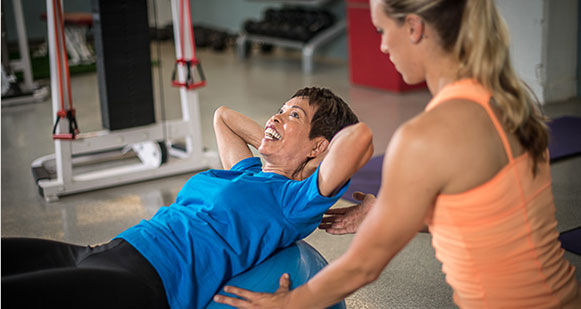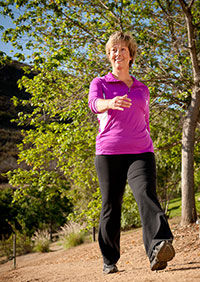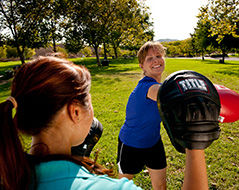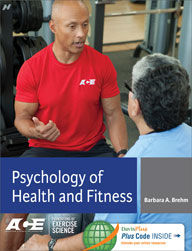
Adapted from Psychology of Health and Fitness. Philadelphia: F.A. Davis, 2014.
People commonly cite fatigue and feelings of stress as their reasons for dropping out of their exercise programs. Exercising takes time and energy, and, when both are in short supply, it is easy to rationalize skipping a workout. In addition, both stress and fatigue feel bad. Psychologists who study health behavior have found that, when people are experiencing negative emotions such as stress, depression, anxiety, anger or sadness, the need to cope with the negative emotion becomes a top priority. The need to feel better now overrides the drive to do something that may lead to future benefits. In other words, if people think a big slice of chocolate cake will help get rid of the depression they are feeling right now, they are likely to eat it, even if they had previously been avoiding desserts to improve their health. If people feel bad, and they think skipping their workout will make them feel better, they will skip the workout, even though they would like to get back in shape. Stress is the most common reason people resume an addiction they had given up, such as smoking or drinking.
As a personal trainer or health coach, you can help your clients stick to their exercise programs by talking to them about the importance of using exercise to manage stress and negative emotions. If they can make the connection that exercise helps them feel good, perhaps they can learn to turn to exercise as a positive way to manage stress and fight fatigue.
Exercise and Mood
Researchers have studied the influence of exercise on mood in many different settings and with a variety of activities. Psychologists use the word mood to refer to how a person feels. Some researchers distinguish mood from emotion, using emotion to refer to shorter, often more intense feelings experienced in response to a specific stimulus, such as something perceived to be disgusting, frightening and so forth. Mood is generally used to refer to more diffuse and longer-lasting feelings that may not be triggered by anything in particular. Another term, affect, refers to the nature of moods and emotions in terms of whether a person evaluates them as positive or negative. The three terms—mood, emotion and affect—tend to be used interchangeably.
Changes in Mood With Exercise
What have researchers found? Changes in mood have been measured before and after a single exercise session, as well as before and after initiating a regular exercise program. Results regarding changes in mood have been similar for both acute and chronic exercise. The most frequently observed changes in mood include the following:

- Energy level: People often report feeling more energetic following a session of mild- to moderate-intensity exercise. They score higher on measures of vigor and describe themselves as feeling more refreshed and invigorated. At higher levels of exercise intensity, subjects with lower fitness levels may be less likely to experience improvements in energy level, while highly fit subjects tend to respond positively to and report feeling energized by even vigorous exercise. Interestingly, while people report feeling more energy after exercise, many also report feeling calm and peaceful at the same time. People enjoy this state of “calm energy.” In fact, many psychologists believe that levels of energy and stress strongly influence people’s moods (Thayer, 2001).
- Fatigue level: Not surprisingly, along with feeling more energy, people report feeling less fatigue. However, following high-intensity exercise, subjects with lower fitness levels may be more likely than highly fit subjects to report more, rather than less, fatigue.
- Negative mood: People report reductions in feelings of depression, anxiety, anger, tension and irritability after a single exercise session, as well as after participation in a regular exercise program.
One study found that college students with higher levels of physical activity reported higher levels of pleasant-activated moods than their less active peers (Hyde et al, 2011). In addition, all subjects reported more pleasant-activated moods on days when they had more physical activity. Subjects recorded their activity levels and moods at the end of each day during this study, so it is unknown whether a better mood caused people to engage in more activity, whether the activity itself was responsible for the good moods, or perhaps some of each. It is likely that physical activity and mood interact, with physical activity causing improvements in mood and positive mood in turn prompting people to engage in more activity.
Variables and Mechanisms Associated With Exercise-induced Mood Changes
The nature of a person’s affective response to exercise probably depends upon a number of variables. Mood is affected by many factors, and all of these factors interact with and influence a person’s exercise experience. Some of the most widely recognized variables include the following.
- Neurobiological changes: The research on endorphins, endocannabinoids and other neurotransmitters such as dopamine and serotonin has established a model in which numerous neurochemicals interact with each other and in response to physical activity. Neurobiological changes that accompany exercise may help to explain mood effects. This is most likely to be true at higher exercise intensities, where greater changes have been found. While, in general, exercise becomes less pleasurable at higher intensities, some people still report positive feelings following such exercise.
Changes in brain electrical activity suggest that increased activity occurs in several areas of the brain, including the limbic system (one of the locations involved with the processing of emotion) and in the ventral prefrontal cortex (also associated with mood states). Researchers have hypothesized that changes in brain activity may reflect changes in neurotransmitter systems, such as changes in the release and binding of serotonin.

- Expectations and cognitions regarding the exercise experience: Just as people who expect to experience inebriation from a laboratory beverage get drunk on a placebo, so might people who expect exercise to feel good experience mood improvements with exercise. People learn from others how to think about exercise. When family and friends have continually told a story of how unpleasant exercise is, a person may come to believe this. Consequently, a person may focus on the unpleasant sensations that accompany exercise and ignore any positive effects. Similarly, prior negative exercise experiences may color current impressions and lead to negative feelings during and after physical activities. The same goes for positive expectations. People who expect to feel good during and/or after exercise are more likely to do so.
Other thoughts influence people’s experiences during exercise as well. Concerns about one’s ability to perform the exercise, perceptions of control over the exercise situation, and other positive and negative thoughts about the exercise experience color a person’s affective response to an exercise session (Rose and Parfitt, 2010).
- Lower stress reactivity: Over time, exercise training is associated with reduced arousal in response to psychosocial stressors. When people have less sympathetic nervous system overactivation in response to daily stressors, they generally have a more positive mood.
Characteristics of the Exercise Experience
Not all exercise experiences are alike. An interesting study compared the response of women to a 10-minute walk at a self-selected intensity both in the laboratory and in an outdoor environment (Focht, 2009). Researchers measured affective state, enjoyment and intention for future participation in walking exercise before, during and after the 10-minute walks. Both indoor and outdoor walking sessions were associated with improvement in affective state. However, scores for the outdoor walking condition showed greater affective improvements, enjoyment and intention to participate in future walking exercise.
Other variables related to exercise enjoyment might include opportunities to socialize, exercise difficulty and activity preference. Exercising with a friend may be perceived as more pleasant than exercising alone or with a group one does not like. Exercise that is not too hard or too long is probably also perceived to be more enjoyable and has a more beneficial effect on mood. A given individual might enjoy and feel motivated by some activities but not others.
Motivating Change: Selecting Activities
To be an effective health and fitness professional, you must be able to help your clients select the best activities possible for their exercise programs. This may involve trading in faster improvements in measurable fitness for enjoyment. Those who work in fitness centers often keep their recommendations focused on the equipment and activities available in the fitness center. After all, clients have likely paid to join the center and want to get their money’s worth by coming as often as possible. But for some people, the fitness center can get boring pretty quickly as they walk on the “treadmill to nowhere.” These clients may do better coming to the fitness center two or three days a week and performing other activities outside the center on other days. For example, they might enjoy walking, golfing, cross-country skiing or other opportunities outdoors. Ask about these options and see if clients would like a little variety, without overwhelming them with suggestions.
To match exercise recommendations to client preferences, ask about his or her previous experiences with exercise. What worked best in the past and why? What were the elements that helped your client stick to his or her program? What led to the client dropping out? Some clients are very forthcoming about their preferences, while others may not have strong opinions. Listen carefully to the stories clients tell about their lives and to their responses to your suggestions. Consider clients’ preferences as much as possible rather than giving them a standard workout that works for most new clients.
Pleasurable Experiences and Distraction From Stress
Psychologists have often suggested that participation in physical activities may lead to improvements in psychological states because it serves as a distraction from the daily grind. This observation is especially useful in explaining why people experience positive changes in mood with activities provoking very little physiological change. For example, people report improvement in mood with playing darts or pool or going bowling, none of which tend to cause enough pain to activate the endorphin or endocannabinoid pathways (unless one is stabbed by a dart or drops the bowling ball on one’s foot). Researchers suggest these distractions nevertheless change the channel on stress by redirecting a person’s focus, perhaps interrupting ruminations on unpleasant tasks at hand.
Pressman and colleagues (2009) performed an interesting study examining the relationship between enjoyable leisure activities and measures of psychological and physical health. Leisure activities were defined as “pleasurable activities that individuals engage in voluntarily when they are free from demands of work or other responsibilities” (Pressman et al., 2009). These activities included both physical activities and other hobbies, such as reading, socializing and so forth. In their study, 1,399 subjects completed questionnaires regarding their participation in leisure activities and the level of enjoyment experienced during these activities. Researchers also measured a number of physical variables, including blood pressure, body mass index, waist circumference (a measure of obesity) and salivary cortisol levels (an estimate of stress level). Pressman and colleagues found that higher scores on the enjoyable leisure activities questionnaire were associated with lower resting blood pressure, cortisol levels, waist circumference and body mass index. A higher enjoyable leisure activities score was associated with better measures of psychosocial states and lower levels of depression and negative affect. The effect on psychosocial measures held across all demographic groups, irrespective of age, sex and ethnicity.
It is likely that enjoyable activities, including but not limited to physical activities, provide a break and pleasant diversion from daily obligations. In addition, positive emotions reduce feelings of stress and dampen negative emotions. Positive emotions themselves enhance psychological and physical health (Pressman and Cohen, 2005). As the famous Dr. Seuss once observed, “These things are fun, and fun is good.”
Behavior Change in Action: Using Exercise to Decrease Stress and Fatigue
CHALLENGE
When clients list stress and fatigue as factors contributing to nonadherence to exercise programs, how can you motivate them to exercise?
PLAN
Motivate your clients to use exercise to fight fatigue and stress by suggesting the following:
- Include emotional health goals in exercise program design: When you work with clients to set goals on which to base their exercise program design, ask about stress. Ask, “Are you ever bothered by feelings of stress or fatigue?” If your client says yes or sometimes, ask, “Did you know that exercise can help you feel invigorated and less stressed?” If they seem interested, explain briefly how exercise has been shown to improve mood and reduce stress.
- Encourage clients to tune into the psychological effects of physical activity: From time to time, suggest that exercise should be having positive psychological effects. If clients are keeping some kind of exercise log, provide a place for recording mood and stress level after each workout. Ask clients how they are feeling after exercise sessions. Are your suggestions causing the placebo effect? It doesn’t matter, since this is not a research project. If you are helping a client stick to an exercise program, the placebo effect is your ally and your client’s ally as well. The power of suggestion can help your client find very real stress relief and mood improvement from regular physical activity.

- Adjust exercise recommendations if clients are experiencing fatigue or a decline in mood following exercise: If exercise is not pleasurable, your client is more likely to quit. It’s better to keep your client involved in a less-than-perfect exercise program than to push for a perfect program they do not perform. Suggest lower exercise intensities, enjoyable activities, working out with a friend or other ideas likely to make exercise more enjoyable.
- Model positive thinking about exercise: Suggest clients change their thinking from “I’m too tired to exercise” to “I feel tired; I think I will exercise, so I’ll feel better.”
References
Focht, B.C. (2009). Brief walks in outdoor and laboratory environments: Effects on affective responses, enjoyment, and intentions to walk for exercise. Research Quarterly for Exercise and Sport, 80, 3, 611-620.
Hyde, A.L. et al. (2011). Unpacking the feel-good effect of free-time physical activity: Between- and within-person associations with pleasant-activated feeling states. Journal of Sport and Exercise Psychology, 33, 6, 884-902.
Pressman, S.D. and Cohen, S. (2005). Does positive affect influence health? Psychological Bulletin, 131, 6, 925-971.
Pressman, S.D. et al. (2009). Association of enjoyable leisure activities with psychological and physical well-being. Psychosomatic Medicine, 71, 7, 725-732.
Rose, E.A. and Parfitt, G. (2010). Pleasant for some and unpleasant for others: A protocol analysis of the cognitive factors that influence affective responses to exercise. International Journal of Behavioral Nutrition and Physical Activity, 7, 7, 15.
Thayer, R.E. (2001). Calm Energy: How people Regulate Mood With Food and Exercise. Oxford: Oxford University Press.





 by
by 






